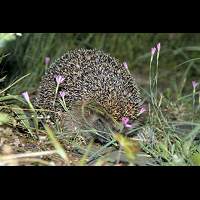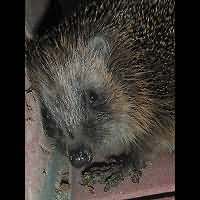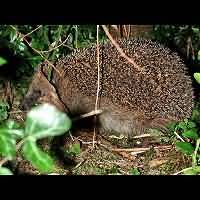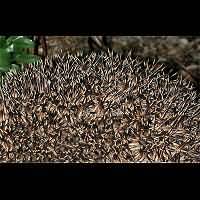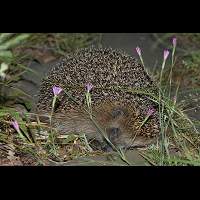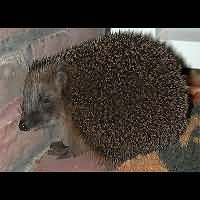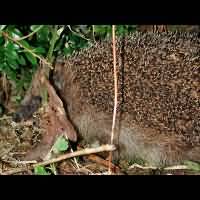[All pictures of garden wildlife on this page are thumbnails. Click on any thumbnail for a large format to be displayed.]
The Hedgehog (Erinaceus europaeus)
Introduction
Hedgehogs, along with moles and shrews, are insect eating mammals (Insectivora). All insectivora are relatively small, primitive mammals. They all have a long snout, sharp teeth, rather small ears and tiny eyes. All insectivores are ancient mammals, the first appeared on earth some 60 million years ago! Like the other insectivora the hedgehog's sight is limited. Therefore they use their smell and hearing to hunt for food. In Western Europe, including most of the British Isles there is only one species of hedgehog to be found. From Berlin towards Eastern Europa another species can be found which is called the Eastern Hedgehog. Hedgehogs live all over Europe, Asia and Africa and they have also been introduced in New Zealand. They are absent in the Americas and the polar areas. The porcupine in Northern and Southern America is not related to the hedgehog at all even though both groups share the spines.
Contents of this page: 1 hedgehogs in the garden, 2 appearance, 3 reproduction, 4 food, 5 hibernation, 6 particulars. 7 hedgehog rescue
(The head of hedgehog shows you that it is closely related to shrews.)
Being nocturnal animals hedgehogs are not often spotted by people but they are very common. Perhaps they can not be seen but they can definately be heard. They can make quite a lot of noise for such a small animal. Looking for food they make snoring sounds, a bit like an adult breething heavily through has stuffy nose. If at night a hedgehog is on his garden safari andhappens to be close to your bedroom window, you might get the impression that there is an adult man about to break into your house! It can be really scary when you are not aware of the real cause of the noise. And if you have heard a hedgehog once the chances are big that you'll hear it night after night for they tend to stick the same area. Since they have but a few enemies, the animals are not very shy. They can easily be approached by humans and only when roughly handled they roll up like a ball in order to protect themselves with their sharp spines standing on ends. You can even attract a hedgehog to come to you by offering dried or canned cat or dog food or a saucer filled with milk. But be careful to offer only special milk meant for animals such as cats.The regular cow milk will make hedgehog sick and it'll suffer from diarrhea. You can buy this cat milk in every pet shop. In no time at all you will see hedgehog at the feeding place every night. Hedgehogs do no harm in your garden. On the contrary, they are quite useful exterminators of snails and slugs and larvae of insects. They are also fond of moths and moth larvae. If you would like to help your hedgehog even further, you could make a pile of old branches covered with leaves. This would give your hedgehog a good nesting opportunity. Hedgehogs build a warm and cosy nest for their hibernation in winter. The females build a second, less robust nest for their young in spring. Should a hedgehog choose your pile of branches in November or December, then leave the animal in peace and don't disturb it. It will soon be sleeping and it prefers to be left alone. It takes energy to walk about in winter and actually this energy is wasted when there is no reason for being active. For badly nurished hedgehog an unneccessary wake up in the middle of winter could even be fatal. Should you ever encounter such an animal, please contact your nearest local hedgehog rescue. Don't hurry though as in milder winters you can find a few hedgehogs walking about. These are not sick or lost, they simply are looking for food! Hedgehogs are capable swimmers and still quite a few of them drown in pools. That is mainly because they are unable to climb out of the pool because of slippery or steep edges. Gradual slopes with mud come in rescue, so does a ramp. The hedgehog that people keep as a pet, especially in the USA, is not the European hedgehog, but an African species, the African Pygmy Hedgehog. The wild European hedgehog cannot be not kept as a pet because of its habit of making noises in its nocturnal activities.
It doesn't happen often but hedgehogs can walk about in daylight.
Click![]() here for the hedgehog's sound.
here for the hedgehog's sound.
Hedgehogs are plump animals with a long snout, small ears and eyes, no tail and a lot of spines on the top of the body. Their closest relatives the Shrews are slender, have no spines, but do have a tail. Hedgehogs are best known because of the long, hard spines. These actually are hardened, hollow hairs. These hairs are dark brown with a light tip and located on the back and sides of the animal. The animal has ordinary soft hairs on both belly and chest. Between the soft hairs and the spines runs a big muscle, which is used to roll into a spiny ball when the animal is threatened. The head and legs completely disappear inside this ball. Once rolled up there are but a few animals that dare to attack it. When walking about the spines point towards each other, but once rolled up, all spines point outwards. An adult animal weighs 1 to 1.5 kilograms (2.2 to 3.3 pounds) and measure some 30 centimeters (12").
The spines point outwards when the animal rolls up.
Hedgehogs live a solitary life. Because they hear very well, they can hear the presence of another hedgehog from far away. That is why they seldom meet and fight, they simply avoid each other. Only during the mating seasons males and females tolerate each other. The mating season lasts only from June till some time in August. After mating male and female go their own ways. The females build a breeding nest, slightly different from the nests in which they hibernate during wintertime and after some six weeks 3 to 10 young are born. Although the babies still have their eyes closed, the spines are already there. These however are white and very soft. Some 14 days later the young open their eyes. The mother takes care of her babies for 6 weeks. After that the young hedgehogs have to take care of themselves. The young siblings may stay together for quite some time and may even hibernate together. Usually hedgehogs only litter once a year.
Even though appearing to be rather intelligent, hedgehogs are very primitive mammals.
Even though hedgehogs are insectivora they will eat almost anything. On their favourite menu are moths and their larvae closely followed by earth worms. But they are scavengers as well and will also eat fruit, soft nuts, snails and slugs. They will try to eat eggs as well even though they are not very good at cracking the scales. Should a hedgehog find a nest of mice or birds, it will not hesitate to eat the young as well. They are fond of adult mice as well but usually these animals are far too fast for a hedgehog to catch. In a hedgehog's diet there is a special place for beetles. They eat every part of them! It turns out that during digestion of betles some blue acid is produced which is very useful for hedgehogs. These are just traces of acid but it is just enough to kill some of the endoparasites such as worms in hedgehog's intestine. In Western Europe adult hedgehogs have merely a few enemies. Badgers are the most important ones, but these have become scarce all over Europe. Some bigger birds of prey and some larger owls also eat hedgehogs. Not even an adult fox is capable of withstanding the spines. Young hedgehogs whose spines are still soft have many more enemies: foxes, martens and many birds will eat them when they discover the nest. Over 100 years ago man ate hedgehogs as well. Gypsies considered the female hedgehogs to be a delicacy. Nowadays humans are the worst enemy: thousands and thousands of hedgehogs are killed each year by road traffic. In spite of all this hedgehogs are far from rare. And if we keep its interests and habits in mind designing and a garden the animal will be with us for a long time to come.
Because of its sharp spines the adult hedgehog has only a few enemies.
The hedgehog is one of the few mammals in Central Europe that actually hibernates. During hibernation the temperature of the body drops to about 8 degrees Centigrade (which is some 46 degrees Fahrenheit). The hedgehog's normal temperature is 35 degrees Centigrade (or 95 Fahrenheit), so this temperature drop is substantial. The hedgehog also slows down breathing, reaching the frequency of 3 to 4 times a minute. Sometimes the animal can stop breathing altogether for almost two minutes. The heartbeat is less than 10 times a minute. In this condition the animal may rest motionless for three to four months. The hibernation of the hedgehog is similar to that of the frogs. Unlike insects that do have a kind of anti-freeze substance in their bodies, the hedgehog does not freeze. Therefore it awakens relatively easily when the body temperature goes above 8 Celcius (or 46 Fahrenheit). When this happens the animal will walk about trying to locate a better spot to continue its hibernation. When a hedgehog awakens its chances of surviving winter diminish because being active in the cold consumes the energy the animal has stored in its fat. For their first hibernation young hedgehogs often build a nest together with the siblings in which they can sleep together. Healthy adults that already survived one winter start to hibernate in November. Young and weak individuals, with less fat stored in their bodies remain active until it really gets too cold. During mild winters these can be seen, even during the day, until the beginning of January. All animals end hibernating in April.
Hedgehogs are always looking for food on the ground.
The hard en sharp spines make it impossible for hedgehogs to clean their skin, That's why they often have a lot of parasites such as flees, ticks, mites and fungae. And because they eat almost anything they also suffer from many endoparasites, such as worms, insectlarvae and bacteria. Many of the individuals seen during daytime are so weakened by all these parasites that they are unable in finding enough food during the night. The animal doesn't like hot and dry summers either. It is impossible to find any more earth worms that are an imporatant source of water. Now man can help his garden friend by offering a saucer of water in the evening. (Attention: Do NOT offer them milk although they seem to like it. Hedgehogs are lactose intolerant so a saucer of milk will make them at best ill and worst be fatal for them.) You might also feed hedgehogs with maggots or worms you can find in pet shops. But in general extra feedings are not needed. Hedgehogs have been taking care of themselves for 60 million years, so there is no reason to believe that they need human intervention to be able to survive. In the wild hedgehogs will live for 3 to 5 years. With perfect care in captivity they may reach the age of 10!
The lower hairs are normal and differ very much from the spines on the back .
Even though hedgehogs do all right in our overpopulated world, they have one big enemy left: cars! Lots of them are killed on our roads each year. Partially it doesn't do a lot of harm, for many of their natural enemies have almost vanished from our civilized world and in a way cars take over part of the predators role. But given the fact that they are friendly creatures and highly useful in our gardens, it is worth a while saving a wounded, weakened or orphaned hedgehog. If you find a sick or injured hedgehog in Britain, call for advice of a local carer on phone number 01584 890 801.

© Copyright 1998-2024 gardensafari.net (Hania Berdys)

 English / engels
English / engels  Dutch / nederlands
Dutch / nederlands